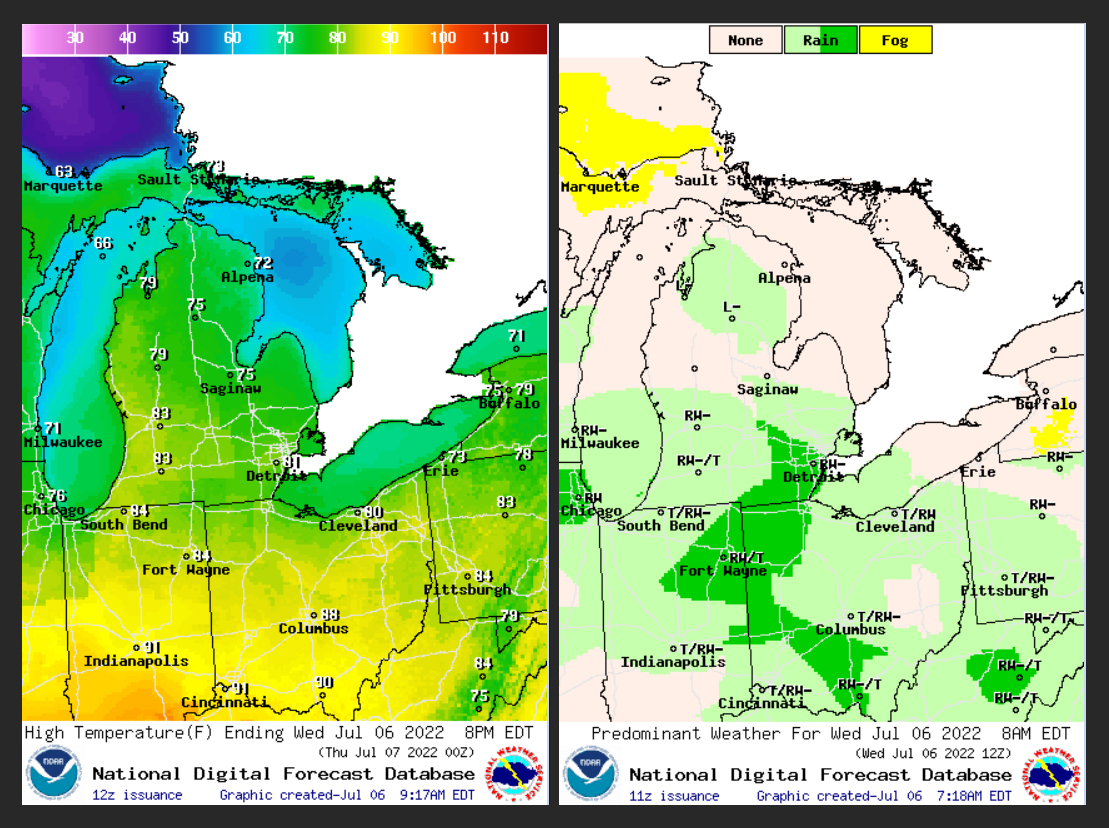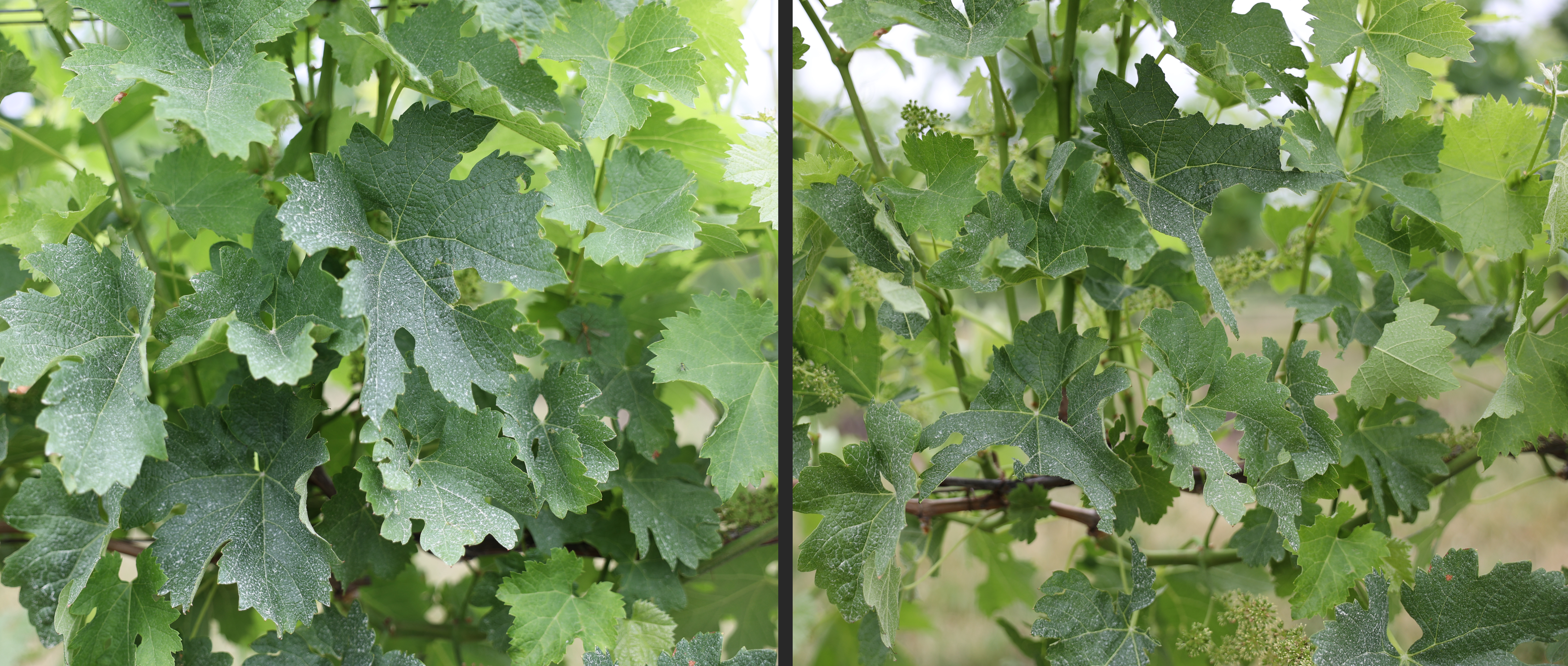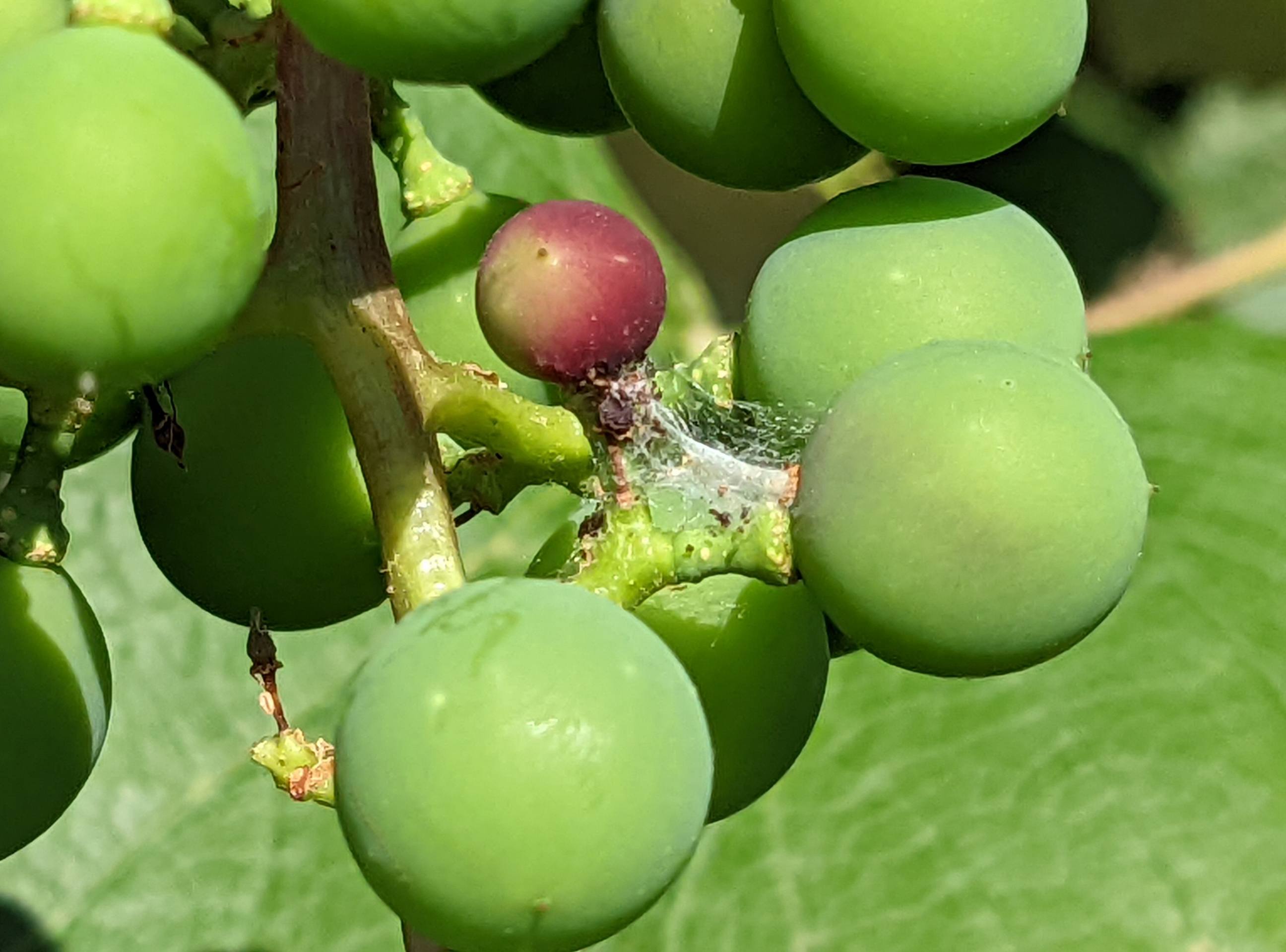Michigan grape scouting report – July 6, 2022
Second generation of grape berry moth egglaying has begun in southwest AVAs.

Weather
This week, the weather will be very mild in the different Michigan AVAs as well. It will be mostly sunny with temperatures in the mid-80s to upper 70s F with a few chances of precipitation in the northwest and southwest and a rainstorm in the Detroit area (Photo 2).

Last week was a warmer week in the southwest and southeast, while in the northwest, Michigan had cooler days and picked up an average of 134 GDD.
Southwest Michigan was the warmest grape-growing region in Michigan, with an average of 186 GDD, 29 GDD more than the previous week.
|
Southwest Michigan GDD Summary from March 1 through July 5, 2022 |
|||
|
Enviroweather station |
Current GDD 50 F |
GDD 50 F last week |
Collected the past week |
|
Benton Harbor (SWMREC) |
1213 |
1027 |
186 |
|
Fennville |
1078 |
910 |
168 |
|
Lawton |
1214 |
1030 |
184 |
|
SW Average |
1190 |
1010 |
180 |
|
Romeo |
1078 |
905 |
173 |
|
SE Average |
1137 |
962 |
175 |
|
Old Mission |
821 |
684 |
137 |
|
Petoskey |
782 |
645 |
137 |
|
Traverse City (NWMHRS) |
865 |
724 |
141 |
|
NW Average |
818 |
684 |
134 |
Vine growth
In southwest AVAs, all the wine grapes have finished blooming.Mainly juice and hybrid grapes at fruit set at the Southwest Michigan Research and Extension Center.
While most cultivars in northern Michigan have reached buckshot berry, late-blooming vinifera are nearing the end of their bloom (Photo 1).
See this chart for grape growth stages.
Horticulture
At this time of the season, early leaf removal (Photo 3) should be completed throughout Michigan.
In brief, early leaf removal is the removal of basal leaves from main shoots and lateral shoots developed from basal nodes and performed between bloom and fruit set as an effective way to control yield, cluster compactness, cluster rot and harvest and improve overall fruit quality.
See this article on Early Season Vineyard Management for more information on leaf removal.

Diseases
This week, most of the grape-growing areas have been relatively dry with mild airflow, and disease pressure has remained low and only in the southwest, in some spots black rot has been observed.
At this time of year, the disease focus is on phomopsis, black rot, anthracnose and powdery mildew. For more information on pre bloom fungicide options and the impacts of rain on disease spread, check out this previous grape scouting report or this article on early season disease management. This week some growers have been finding sparse downy mildew and downy mildew infections on flower clusters in vineyards.
As bloom continues in the Northwest and it gets close to finishing in southwest Michigan, early season viticultural practices must be considered because the practices can significantly reduce canopy wetness and increase airflow, consequently reducing disease pressure later in the season.
In this growing stage, you should consider choosing fungicides that control all the fruit diseases. For example with downy mildew we are most concerned with fruit infection at this time and sprays should be timed prior to bloom and at bloom for optimal control. Downy mildew is caused by a fungal-like organism, so many site specific systemic fungicides that target other spring diseases do not work on downy mildew. Effective fungicides for downy mildew include products in FRAC codes 4, 11, 21, 40 and 45 as well as phosphorus acid salts and some biologically-based products.
With the exception of powdery mildew, these spring disease infections typically require rain events. It only takes 0.1 inches of rain above 50 degrees Fahrenheit to trigger a possible infection. Viticultural practices that reduce canopy wetness such as good irrigation timing, leaf removal and good weed management can reduce many of these diseases in a vineyard. Typically, DMIs (FRAC 3), captan and EBDCs (FRAC M3) are effective for phomopsis, black rot, and anthracnose.
Insects
In southwest AVAs, second-generation Grape Berry Moth (GBM) egg-laying has begun. The Lawton area will reach 910 GDD and egg hatching is predicted to start onWednesday. Damage is being observed in vineyards with high pressure, most with only one to two berries affected per damaged cluster (Photo 4), but some with 5-6 berries at very high-pressure sites . In the high-pressure sites, additional sprays after the spray at biofix will be needed to keep coverage intact and infestations in check.

Some thrips damage is also appearing now on berries from feeding on clusters earlier in the season. As soon as fruit-set occurs, thrips can damage very young berries. Later, the scars may inhibit berry growth, resulting in berries with unusual shapes or scars.
Leelanau, Grand Traverse and Emmet Counties are still reporting rose chafer damage. reported a medium to large population of rose chafers this week. Feeding rose chafers can damage the leaves, flowers, and buds of grape, blueberry, raspberry, blackberry, and strawberry plants. Because adults can consume large amounts of plant tissue, the rose chafer beetle has the potential to harm Michigan's small fruit crops. This light tan beetle with a darker brown head and long legs emerges in June and has been observed feeding on most small fruit and tree fruit crops recently. Sightings of these insects have increased in recent weeks throughout Michigan's fruit-growing regions, and growers should be especially cautious if they have crops on sandy soils, where this pest is more common.
Tumid gallmaker and grape cane gallmaker infestation is also more evident now in some isolated spots in SW Michigan. Once the galls are developed it is too late to control these, so if they are at economic levels, put a note in your calendar for June 1, 2023 to keep a close eye on the hotspots for pest activity next spring.
Upcoming events
The Southwest Michigan Viticulture Field Day will return to the Southwest Michigan Research and Extension Center for 2022. As tradition holds, the event will be the last Wednesday of July (July 27, 2022) and will include presentations of ongoing research in southwest Michigan. The event will once again conclude with a steak dinner and local wine tasting. Registration for the Viticulture Field Day is online through the Michigan Grape Society’s website.
Register for Dirt to Glass 2022: Elevating Michigan Wine from the Ground Up. Michigan State University Extension is hosting a new conference for the Michigan grape and wine industry. Dirt to Glass 2022: Elevating Michigan Wine from the Ground Up is the first ever of its kind in Michigan and this year it will take place in Traverse City on August 25-26. This year's Dirt to Glass conference will focus on soil health, soil identification and soil fertility. Each year, the conference chooses a specific area of study based on the results of an annual educational needs assessment survey. Registration by July 10 is required.
Tile Drainage Field Day 2022. Linking Soil Health, Nutrient Management, and Water Management for Improved Water Quality. The event will be hold on Thursday, Aug 25, 2022 at 13000 Bird Lake Rd., Camden, MI 49232
Related articles
- Early season vineyard management
- Early season control of grape berry moth in Michigan vineyards for 2022
- Rose chafer management for northwest vineyards
- 2022 Fruit insecticide registration update
- Southwest Michigan fruit update – June 28, 2022
- Michigan grape scouting report – June 22, 2022
- 2022 MSU Fruit Pest Management Guide (E-154)
- Grape growth stages
- Early season vineyard disease management
- Early season vineyard management
- A Mobile Guide for Grape IPM Scouting in North Central and Eastern U.S.
- Using the MSU Enviroweather grape berry moth model in 2018
This work is supported by the Crop Protection and Pest Management Program [grant no 2021-70006-35450] from the USDA National Institute of Food and Agriculture.



 Print
Print Email
Email
